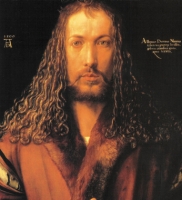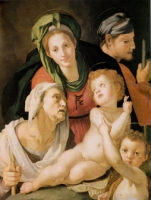25 Feb 2011
The Spell of Gossaert
The Jan Gossaert (c.1478-1532) exhibition that was on at the Met in New York last year has now moved in truncated form to London’s National Gallery. There are 37 of his 63 extant paintings in London. The Met had 50. Yet there i
21 Feb 2011
As Time Goes By
Irina Werning, an Argentine photographer, takes pictures of friends re-enacting photos from their youth and then depicts them side-by-side. I find them fascinating, in part because we all age in slow-motion, in part because the resemblances betw
15 Feb 2011
Recent Reading
If anyone noticed the reduced activity on the site over the past ten days, forgive me. I was on a beach where, in between downpours, I got the chance to catch up on some reading. Three books in particular are worth recommending:
John Sp
30 Jan 2011
Note on Style
Style, the traditional method of classifying art, is rarely mentioned on this site because it has little effect on interpretation. Mark Roskill, the late art historian, wrote in his book The Interpretation of Pictures:
‘Discussion[s]
28 Jan 2011
Reality, History and Minor Masters
If you want to learn about the history and culture of a period, you’d be better off studying minor painters like the one above. They generally copy reality faithfully like an art student painting a landscape. Great masters, however, design
27 Jan 2011
Larry Rivers and Reincarnation
There is a common idea among major artists that they are part of a continuum of artists with whom they feel at one. So much so, that they can easily take on each other’s identity in a painting: Manet as Rubens, Matisse as Rembrandt etc. Ar
24 Jan 2011
My I-Touch Gallery
Here’s a tip for anyone collecting images of art on their computer and who would like to consult them while visiting a museum? Download images of paintings, drawings, sculpture and prints onto an I-Touch or I-Phone. They can be very useful
21 Jan 2011
What Graphic Designers Know
Artists put meaning in their work by using methods that most viewers never see. Indeed that's what this website's about. Graphic illustrators put meaning in their work too. What few know though, perhaps even themselves, is that they
21 Jan 2011
One of the 50 Best!
Here's a pat on our own back! We are four months old now and have just been listed on Master Degree's List of the 50 Best Art History Blogs. You might want to visit it yourself. It's a useful resource.
And, by the way, pleas
17 Jan 2011
Manet’s Errors
Edouard Manet would have been amused by his critics, then and now. In the 1950’s Clement Greenberg placed Manet at the center of his theory that modern painting had no meaning beyond emphasizing its own essential character. Thus the “flatnes
14 Jan 2011
What do Contemporary Artists Know?
Why do so many contemporary artists place themselves at the center of their work? Think about it. Yasamusa Morimura paints himself into his copies after old masterpieces; he’s not the only one to do so either. Cindy Sherman has photographe
13 Jan 2011
How Swords Become Paintbrushes
Even though artists across the ages have morphed swords into paintbrushes and spears into etching needles, few have ever been recognized. Indeed the use of weapons as visual metaphors for the tools of an artist is so widespread in art generally
08 Jan 2011
Picasso and Paul McCartney’s Two Fingers
Alberti’s Window, an art history blog, has an intriguing video of Paul McCartney discussing the origin of his song Two Fingers. McCartney was in the waiting-room of a hospital staring at a poster of Picasso’s painting, The
03 Jan 2011 | 1 Comments
Why painters paint themselves
I spend so much time demonstrating that conventional perception of art is mistaken that I seldom explain why every painter paints himself is such a profound idea. It is, in essence, the basis of consciousness. Every time we recount a childhood s
29 Dec 2010
Me! Me! Me! and the Identity Museum
“Me! Me! Me! That is the cry, now often heard, as history is retold. Tell my story, in my way!” That’s how The New York Times begins an account of a new phenomenon, the “identity museum”.1 An “identity museum&
26 Dec 2010
Happy New Year!
Happy New Year, One and All! I know it's a little early but I won't be adding much between now and New Year's Eve. Too much other stuff to do...back-up work to keep the site going.
However, if you happen to know anybody who
21 Dec 2010
Velazquez and the King’s Left Eye
The Metropolitan Museum announced yesterday that it has re-attributed the earliest known painting of King Philip IV by Velazquez (left) to the master. In 1973 during a reconsideration of all their European holdings they downgraded this portrait
18 Dec 2010
A Visit to the French Ambassador
I’ve just been to see Palazzo Farnese, the great French Embassy in Rome, partly designed by Michelangelo, which is rarely open to the public. They’ve arranged a wonderful exhibition with loans from Naples and Parma to celebrate the F
15 Dec 2010
Mona’s Eyes are Lettered
Last week we demonstrated how Nicolas Poussin’s Ordination includes the unseen face of Christ with Poussin’s own initial, N, painted over Christ’s eye. Christ, we explained, is the divine artist in Poussin’s own mind. Now news comes from
09 Dec 2010
Exit the King
Anyone wondering why artists represent themselves as kings – why Fouquet painted himself in 1450 as Charles VII or Ingres as Napoleon or even Lucian Freud as Queen Elizabeth II - might like to read Eugène Ionesco&rsqu
06 Dec 2010
How Mr. and Mrs. Robert Andrews are one and the Same Person
This painting, a British icon, is considered one of the National Gallery's most important masterpieces but, as we show in our most recent entry, it is largely misunderstood especially by the gallery itself. The Gallery and many critics think
04 Dec 2010
Steve Martin’s Artworld Fiasco
People may have more schooling nowadays but they seem no more educated. According to the New York Times, Steve Martin was at the 92nd Street Y in Manhattan this week to talk about his latest novel on the artworld and there was a large audience o
03 Dec 2010
Giacometti in New York
If you are in Manhattan for the Christmas shopping season and need a few minutes' peace, pop on over to the Eykyn Maclean Gallery at East 67th Street where a small but magnificent collection of Giacometti drawings and sculptures are on displ
26 Nov 2010
When art was not art….
Here’s a thought for the day from an excellent introductory text, Herbert Kessler’s Seeing Medieval Art (2004). “The production of art”, he writes of medieval images, “was understood as a spiritual act, inspired by
24 Nov 2010
Why do artists fib?
The secrecy with which artists create is an enduring topos but not one that those interpreting art pay much heed to. The stories that are particularly intriguing are the ones in which artists seem about to explain their meaning only to end up mi
23 Nov 2010
Art and Eckhart
“Knowledge of Meister Eckhart’s work is indispensable to the understanding of medieval art, even though he has been almost totally neglected by those who like to call themselves ‘historians of art.’”
So wro
21 Nov 2010 | 2 Comments
Basquiat in Paris
Basquiat at the Musée de L’Art Moderne in Paris is well worth seeing for anyone who wants to come to grips with this difficult artist. It is amazing to see how much one man can produce in a short time, especially if one considers that what’
19 Nov 2010
Bronzino’s Ginger Hair
No-one knows how Agnolo di Cosimo gained his nickname, Bronzino, but the general view seems to be, without any evidence, that he may have had a dark complexion. Yet how about the color of his hair? A portrait of Bronzino by an unknown painter sh
17 Nov 2010
Bronzino’s Mirror
I just discovered a self-portrait of Bronzino that I did not know. According to the catalogue for the current exhibition in Florence and earlier scholars too, Bronzino depicted himself in a religious painting as the poet-king David (above right)
10 Nov 2010
Gauguin’s Method
I was reading about Gauguin today and his own explanation of The Vision after the Sermon: Jacob Wrestling with the Angel. It struck me that if I was trying to explain this image I would say the same: that the figures in the foreground represent
The EPPH Blog features issues and commentary.





























